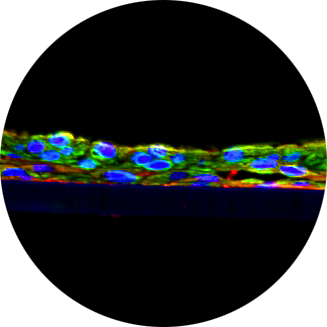Automated Transepithelial Electrical Resistance (TEER) Measurements Allow for Rapid Screening of the Gastrointestinal Toxicity Profile of Therapeutics
- TR Number: 1058
- Authors: Kaitlyn Coen, Subhra Nag, Mitch Klausner, Doug Bleau, Adrienne Watson, Tim Landry
- Materials Tested: ethylene glycol tetraacetic acid, EGTA, dextran sulfate sodium salt
Gastrointestinal toxicity (GIT) ranks among the most common clinical side effects for many orally administered pharmaceuticals, in particular for oncology drugs which are administered over an extended time period. Previously, we utilized an in vitro small intestine (SMI) microphysiological tissue model, EpiIntestinal (Mattek Corporation), which contains the epithelial cell types resident in the native human gastrointestinal tract, and transepithelial electrical resistance (TEER) measurements to evaluate the GIT profile of therapeutics and to predict oncology drug-induced diarrhea1. TEER is a non-invasive technique commonly used to monitor barrier integrity in 2D monolayers and 3D tissues. Daily TEER measurements were made over a six-week period, a typical therapeutic timeframe for oncology drugs, to monitor barrier integrity of 3D EpiIntestinal tissues grown on permeable membranes in 96-well insert plates. Manual TEER measurements were made on one tissue at a time, requiring 35-40 minutes to complete measurements for all 96 tissues. This manual method of measuring TEER limited the throughput of drug screening capabilities of the assay method, which is critical for the application of microphysiological systems in drug discovery and preclinical development. To overcome this challenge, we utilized the EVOMTM Auto instrument (World Precision Instruments), a high-throughput TEER measurement system, which can accurately and reproducibly measure the TEER of a 96-well plate in 4 minutes and 10 seconds. The EVOMTM Auto can be housed within a biological incubator or biological safety cabinet and run using a scheduled cycle mode, an additional feature that improves the ease of use. The EVOMTM Auto significantly increases the screening throughput, avoids technician fatigue, and increases the accuracy of TEER measurements by automating consistent measurement locations within the well. In this study, we investigated the ability of chemicals which cause short-term (ethylene glycol tetra-acetic acid (EGTA)) and long-term (dextran sulfate sodium salt (DSS)) reversible barrier disruption in the EpiIntestinal model and demonstrated a controllable and reversible effect on barrier function as evaluated by automated TEER measurements and a Lucifer yellow permeability assay. These results demonstrate the applicability of the EVOMTM Auto to monitor and evaluate the SMI microphysiological tissue model for drug and chemically induced GIT and barrier phenotypes as seen in diseases like Crohn’s Disease and Colitis. Implementing the EVOMTM Auto into this workflow enables high throughput TEER measurements, resulting in rapid and reproducible readouts of barrier integrity for drug screening applications.

